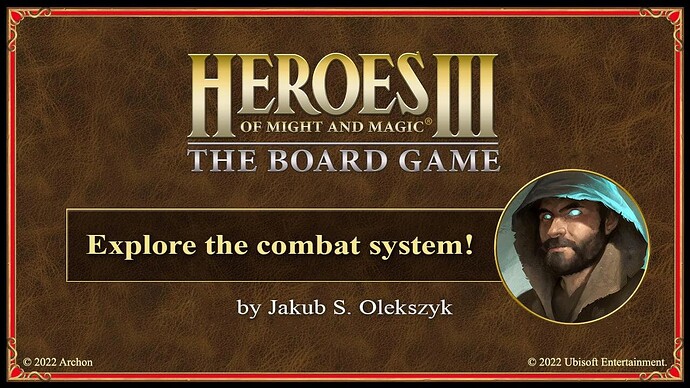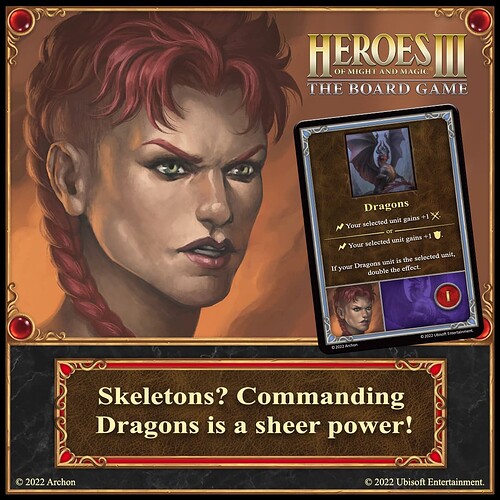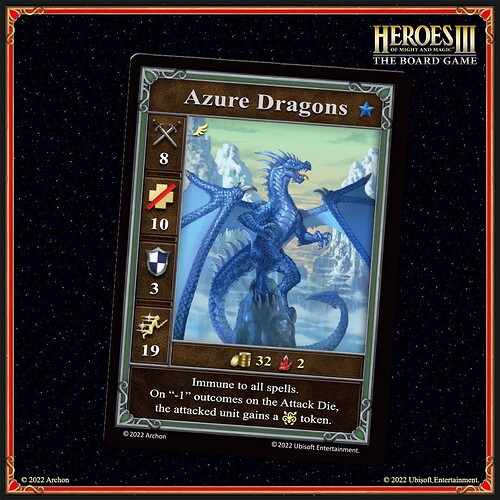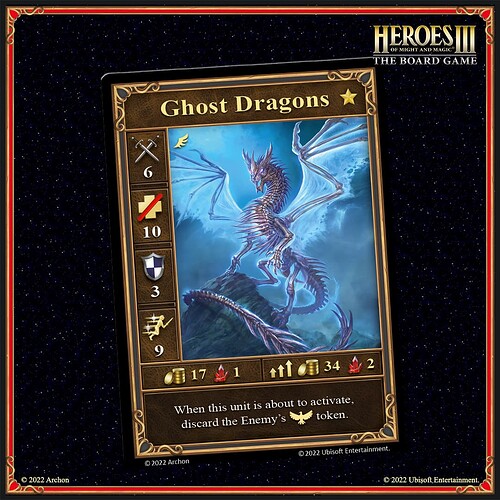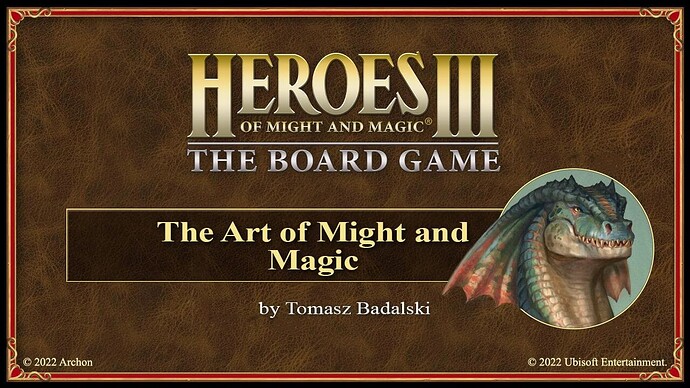Elles sont superbes, un régal pour les yeux
Je profite du retour de mes vacances pour mettre le nouvel article d’il y a quelques jours, surtout que ça concerne le système de combat, si certains ne l’ont pas encore lu…
The Army, or to Enroth and to Antagarich Back Again
Let’s move on to the next element that makes Heroes of Might and Magic III so wonderful - units, armies, and combat!
As with the other core mechanics of the original, we tried our best to bring them into the board game. Of course, this required some simplifications and efforts to keep the game smooth and exciting. Yes, in the board game, each faction has 7 units available in the town, but, like in Heroes of Might and Magic I, the Hero can only recruit 5 of them. We have changed the levels of units (and their dwellings) to the following groups: bronze (levels 1-3), silver (4-5), and gold (6-7)… Mighty dragons, in honor of the most powerful creature in Antagarich, we have marked with azure.
A Peasant is a peasant is a peasant is a peasant - Unit Cards
Of course, the above distinctions are not everything. Each unit has its own type - ground, flying, or ranged. It is closely related to the number of spaces it can pass on the battlefield. When activated, a ground unit can move up to two spaces, a flying unit can move up to three (can fly over other units too), and a ranged unit can move only one space. In addition, the unit cards show their statistics - attack, defense, hit points, initiative, and potential special ability.
At the bottom of the unit card, you can find recruitment costs - how many resources you need to spend to add a unit to your army or to increase the size of its squad. In Heroes of Might and Magic III: The Board Game, the unit cards are double-sided. One of the sides shows a given unit in the range of a few, and the other side in the range of lots; so when a unit’s hit points in the range of lots are reduced to 0, it does not leave the battlefield - its card is flipped so that it can continue combat - but from now on in the range of a few.
Combat is what Heroes do best
Now let’s look at what knights or barbarians (wizards too!) like the most - combat! In Heroes of Might and Magic III: The Board Game, it is played on a special 5-row combat board. Each player, at any time during their turn may deploy their army within the two back rows. After the battle begins, the Hero can no longer rearrange their formation (unless they have a Tactic card).
There are two types of combat: fighting neutral units and fighting Heroes:
Fighting neutral units
Neutral units on the map are marked with Roman numerals, which indicate the estimated level of the army (i.e. how many cards to draw and from what pile). It is also related to the difficulty settings you choose at the beginning of the game. It is obvious to guess that on the easy level, the Hero will not encounter opponents as strong as the ones in the impossible difficulty level.
I already mentioned that a player cannot change the deployment of units after a battle has started… But what about neutral unit cards? Well, the previous player is responsible for their deployment and actions. We have taken to heart the threat of endless battles, so the Hero has to deal with a neutral unit in one round of combat (the exception is, of course, units from the azure deck); if they want to extend the battle for another round - they must spend a movement point.
Combat itself is played in the order of initiative - all units activate one after another, according to this parameter. In the case of ties, the attacking side has priority. Each unit can move and attack (against the enemy’s possible defense and hit points); if the attacked unit survives - once during a combat round - it retaliates.
Fighting Heroes and gaining experience
The Heroes’ combat follows the rules described above. This time, however, both players can use cards from their hand (when fighting neutrals, it can only be done by the player controlling the Hero). There is also no round limit. It is also worth mentioning that just like in the computer game Heroes can retreat or surrender, losing part of their army, currency and their position on the map. Winning combat also results in gaining experience for the Main Hero - for defeating a Hero or a neutral unit of the same level, they gain half a level, and in the case of higher levels - they are promoted by the difference between their levels. For example - Alamar on experience level II defeated Sandro on experience level IV, thanks to which he was promoted by two full levels. On the other hand, when the Hero attacks neutral units with a level lower by at least 1, the battle does not take place - the enemy units flee in panic, and the Hero does not gain experience (yes, this is another element that guarantees smooth gameplay).
There is one last castle, your final chance, so take it…
But that’s not all; combat in Heroes of Might and Magic III: The Board Game is not just a cut and dry calculation. The deck of Might and Magic has a number of possibilities that allow you to mold the battlefield - spells or artifacts can be a real game-changer. The same can be said for unit abilities. In addition, the original damage range has been converted to the Attack Die - before players calculate the unit’s attack and damage dealt, the die modifier (ranging from -1 to +1) is also taken into account. Another addition that many players can expect to see is the besieging of towns. In this case, combat is played according to the standard rules, but the defender has access to walls, gate, and turret on the middle of the combat board.
Stay tuned!
When we started working on Heroes of Might and Magic III: The Board Game, we were aware that apart from exploring the map, combat would be key to the success of this project. I will not hide that we tested various concepts, finally choosing the one that seemed to be the best (also looking at the smoothness of the game). I hope you will like it.
Possibilité de voter pour la langue que l’on veut, go si ça peut permettre d’avoir une VF!
https://archon-studio.com/content/what-language-edition-you-would-buy
A voté !
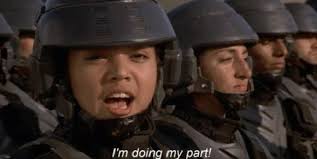
Pas mieux…
Tu pourrais voter deux fois. Fainéant.
j’ai voté 3 fois avec mes 3 navigateurs on sais jamais ![]()
A voté. (Pour le français ![]() )
)
hop… a voté
Voté, mais franchement je trouve l’approche hasardeuse vous ne pensez pas ?
Ils ont communiqué où sur ce sondage ?
Quelqu’un avait partagé le lien sur un groupe Facebook mais je sais plus lequel, d’après l’URL du lien ça venait d’un mail, j’ai supprimé tout ce qui servait à rien avant de partager pour pas avoir un lien a rallonge.
La newsletter…
Et moi 6 fois (du taf et chez moi)
Petit partage avec Sandro the Necromancer…
Ladies and skele-men, introducing the one and only Sandro the Necromancer!
We couldn’t resist bringing back one of our favourite heroes and playstyles into the board game: Summon an undead army, make them stronger with the Cloak of the Undead King, and curse your opponents.
Would you build a mighty Castle or a sprawling Necropolis?
Aaaahhh Sandro… ![]()
J’espere qu’on aura une vf que j’ai une vraie raison de craquer xD.
Ca a l’air dingue !
Au tour des Dragons…
Every hero would love to have a dragon by their side. Mutare with her command dragon specialty can certainly cause serious havoc
Especially with these cards in her hand - have a look at the Dragon Units!
Cette semaine nouvel article sur les illustrations et l’aspect artistique ou comme le dit Tomasz: From late 90’s pixel art to 2022 board game components, look at how we combined a classic design with a more modern approach to capture the spirit of Heroes of Might and Magic III.
The Art of Might and Magic
When asked what made Heroes III so popular, Gregory Fulton replied that there was lots of beauty in there.
The computer version of the game has been charming us with its aesthetics for over 23 years. A team of talented artists from New World Computing managed to create an absolutely timeless piece of art, unchanging in its beauty, even through the flow of time and increases in technological development.
When the artistic direction of our board game was developing, my main goal became to understand what exactly lies behind the genius of the original, and how we can translate a number of great solutions from a computer game into the medium of board games. This seemingly simple task required a lot of care. Unfortunately, we weren’t able to use graphics from the original as there would be a number of problems putting the original art directly onto the cards; namely the resolution scale on some of the larger cards. In order to adapt the visuals from the original into a board game, we needed to add many smaller details.
Finding The Right Balance
The starting point for working on each of the decks was not only to take the design from the original but also to understand the philosophy behind it. Illustrations from the computer game still bring joy to the eye because they were drawn by enthusiasts of art and games. Therefore, the materials for our project had to be created in the same way - with passion. That’s why I have ruled out any AI tools or filters that would be able to upscale the resolution of the original assets or make them look “better”. It would drain them of their soul.
Illustrations of spells or abilities were created with the intention to accurately reflect the original concept, which has always been loved by fans, but also adds missing information where necessary, or removes it where it clashes with the layout of the card.
The Heroes
The hero portraits in HoMM stimulated our imagination from the very first moments of the game. The distinct characters of the noble knights contrasted with the power-hungry Necromancers told such a rich story that each playthrough felt like something special.
Our phenomenal team perfectly captured the atmosphere enchanted in these small pictures from the game and translated it into a much larger format.
The task was much simpler in the case of already made ones, but there are also some heroes in the game who never got a painted version of their portrait. Not until now.
The Units
Graphics based on the illustrations of such legends as Phelan Sykes or George Almond will go to the game unchanged. They are perfectly defined and leave us with no dilemmas. However, with some faction units in the game it wasn’t that easy. Some of them only exist as small pictures. Some are 3D models with a small number of polygons. In these cases, we gave ourselves a little more creative space to be able to interpret what the original was trying to show.
We all know that nostalgic feeling from our childhood when the titles seemed completely realistic and the animations were incredibly fluid. This experience had an exceptionally strong impact on our team, especially Iana Vengerova, the lead artist who created the graphics for the board game. That’s why we decided to recreate well-known units from the game using our countless hours of playing Heroes as the basis.
The first versions differed slightly from the iconic designs, but together we managed to find a way to strongly refer to the game.
In the game, you can also find neutral units with equally phenomenal illustrations.
The Layout
The design of HoMM3 allows us to translate the style from the game to the board almost 1:1. The game has almost all the icons we needed to design well-functioning gameplay. The sharp and atmospheric frames known from the game proved to be very distinct on the cards. The book of spells inspired us to create spell cards stylized as single pages from the spell book. The reverse of the card is a reference to the UI, and contains many familiar symbols. Each of these elements was created to maintain the atmosphere of the original that we all know and love.
The Six Horsemen of the Apocalypse
Each faction in the base game contains two figures, a hero of Might and a hero of Magic. As in the game, the figures aren’t meant to represent the heroes literally. Rather, our focus was on reflecting the general atmosphere of a given faction. This, in turn, allows for a greater variety of heroes to choose from during the game. It also allows for more freedom in designing different models and is a clear reference to the mechanics of the original game.
The miniatures were designed so that each faction felt unique. They differ in silhouettes and poses. The heroes of Dungeon as battle-hardened warriors are full of unbridled energy, the heroes of Castle are distinguished by dignity and nobility while the heroes of Necropolis can terrify anyone with a mere glimpse. Clear differences also allow you to easily distinguish the figures during the game.
Miniatures
In addition to the heroes, everyone’s favorite units will also appear in the game as figures. Carved with the utmost attention to detail, they beautifully fill out the battlefield. Their poses reference special in-game attacks or the way they move. For instance, the Zealot is in the middle of making a sacred attack, the Minotaur strides confidently while destroying everything along the way, and the Evil Eye is getting ready to fire a deadly beam.
Summary
When we started working on Heroes of Might and Magic III The Board Game, we knew how much fans love the visuals of the game. Our goal was to create a game that would be a tribute to the classic and at the same time give some room for our great artists, which we gathered while working on the game. I hope fans of the original will feel the wonderful atmosphere of the game once again by opening the box of our board game.
- Tomasz Badalski - Art Director
J’adore : c’est simplet et élégant, fidèle à l’ambiance du jeu vidéo.
